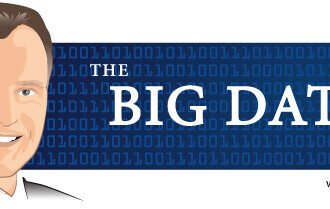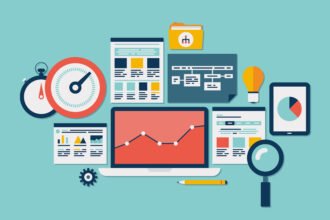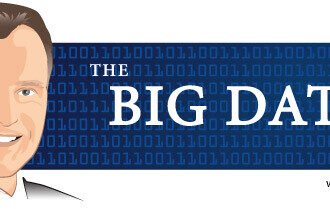Big data and financial services are natural match – after all, with nothing to manufacture, and no physical product to sell, data is the bedrock the industry is built on. On top of that, most of their business is quantitative – they mainly deal in good old-fashioned numbers – the simplest data to record and analyse. But therein also lies the problem – because of its simplicity, pretty much anyone can do it. So if you’re a hotshot financial whizz-kid looking to boost your employer’s profits (and secure yourself a nice fat bonus) you need a competitive edge. Big Data is giving financial firms this advantage in three different ways. 1. Data-based Market Insights and Trading Decisions Computers can be much better at making some types of decision than people. They calculate far more quickly, make fewer logical errors, and don’t get emotionally involved. This is why for some time now the majority of trading on financial markets has been carried out by algorithms designed to buy or sell with no input from humans. High Frequency Trading (HFT) is the common example – it’s been around since the turn of the century, and involves a computer making hundreds, thousands or millions of trades, often just making a tiny profit on each one. But of course, millions of tiny profits soon add up to one very big one! Sounds great right? Well, HFT is not without its critics. But in the last couple of years profits from this sort of trading have started to fall. Partly this is due to less turbulent market conditions – when there are less dramatic swings in value, the amount of money to be made falls. But it’s also due to saturation. When a greater number of people are using advanced technologies which eliminate inefficiency from the system, the system becomes more efficient as a whole – meaning there is less money to be made from taking advantage of the inefficiencies. This means that financial companies looking to get ahead have to develop more creative and innovative ways of using data to predict the future, to work out which corporations are going to turn a profit, and which commodities people will be buying and selling. The finance industry generates mountains of raw, quantifiable data – today every financial transaction is logged and added to the pool of data that’s available for data scientists to work their magic with. In the past, it has all been about speed – the main benefit that technology brought to the industry was the ability to monitor and respond to changes in the world financial markets as quickly as possible, over and over again. This gave the financial institution an advantage over its competitors, allowing them to return higher profits to its shareholders and investors. Structured data is perfect for this – but with profits from HFT falling quickly (at its peak in 2009 the industry made around $5 billion on stock trades, this was thought to have fallen to $1 billion by 2013) analysts are looking elsewhere for the insights that will give them the edge – and often this means unstructured data. Traders and lenders are looking for better ways to make sense of the constant stream of information – from news reports to eyewitness accounts on social media – to work out how real-world events will translate into market movement, and increase their trading and investment profits. Of course, if there’s one constant within the finance industry, it’s that from time to time, things will go horribly wrong. One famous big data-related example of this is known as the “hash crash”. In April 2013, a hacker accessed the Associated Press Twitter account and tweeted that Barack Obama had been injured in a terrorist attack. Automated systems reacted as they were programmed to, probably assuming World War 3 was about to break out, and began selling off shares – resulting in a loss to the market of $136 billion. Things will hopefully improve – the financial incentive is certainly there, and new services are emerging – i.e HedgeChatter which promise greater-than-ever accuracy of prediction, by monitoring the social media output of thousands of “influencers”, scanning them for keywords which historically have led to market movements. 2. Data-based Customer Insights As well as trying to improve the way they anticipate market reactions, banks are looking to use big data to become more customer focused. This also means tapping into the reams of unstructured data – lifestyle information, social media activity, customer feedback and support requests, for example, to improve customer retention and acquisition. One of the first to do so and report on its results was the Oversea-Chinese Banking Corporation (OCBC) based in Singapore. Starting in 2005, they analyzed customer information before putting into place a targeted marketing strategy based on their findings, which led to a 40% increase in acquiring new customers, and 60% increase in cross-sales of related products to existing customers. 3. Data-based Fraud Prevention After anticipating the markets and improving customer service, a third use that the world of finance is finding for big data is combating fraud. With more than 50% of fraud undetected until after the event, when money has been lost which may be difficult or impossible to get back, the focus has shifted towards analyzing patterns to determine where fraud is most likely to occur, so preventative action can be taken. If you have had a digital transaction declined– at a store with a credit card, or online – for apparently no reason, you may have fallen foul of fraud prevention algorithms which analyze everything from your location to the speed it takes you to enter your username and password, to determine whether you are legally entitled to make the transaction. The security systems are comparing your behaviour to that of millions of other historical ones – some of which it knows are fraudulent – and if it matches a number of criteria associated with illegal activity, it will be blocked. This can be inconvenient when your card is declined at the checkout – online or bricks and mortar – but as the amount of data continues to grow and algorithms become more accurate, it is likely to reduce the vast amount of money that simply evaporates every second due to fraud and theft – and this will be a good thing for everybody, except the criminals!









